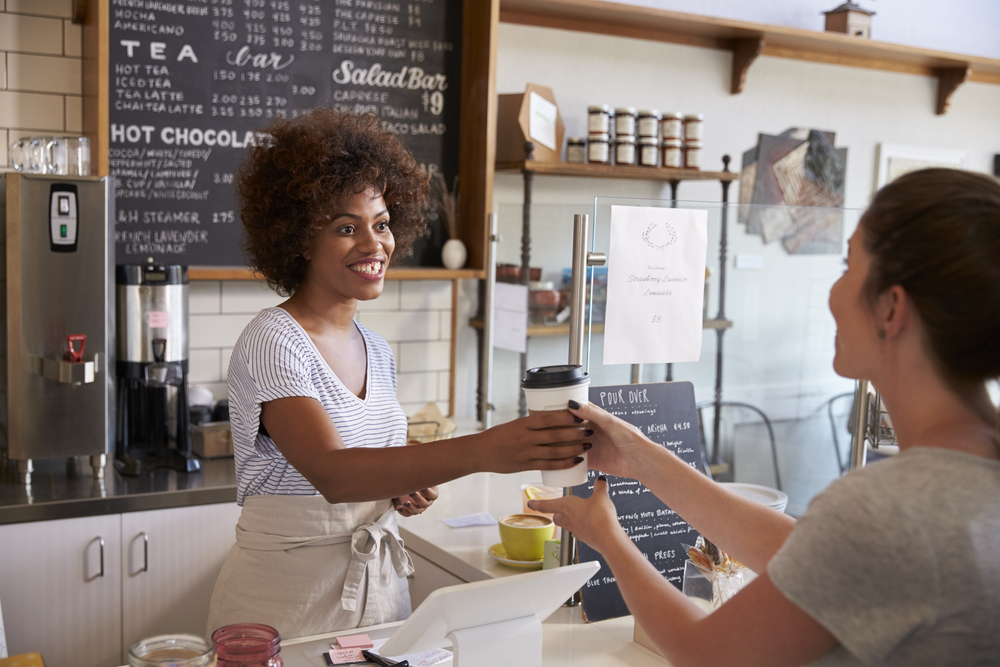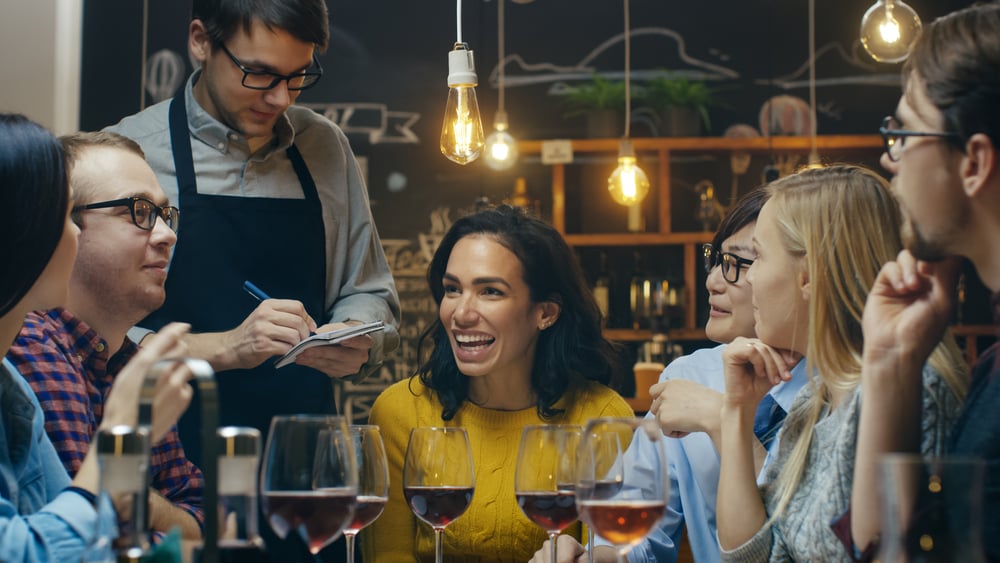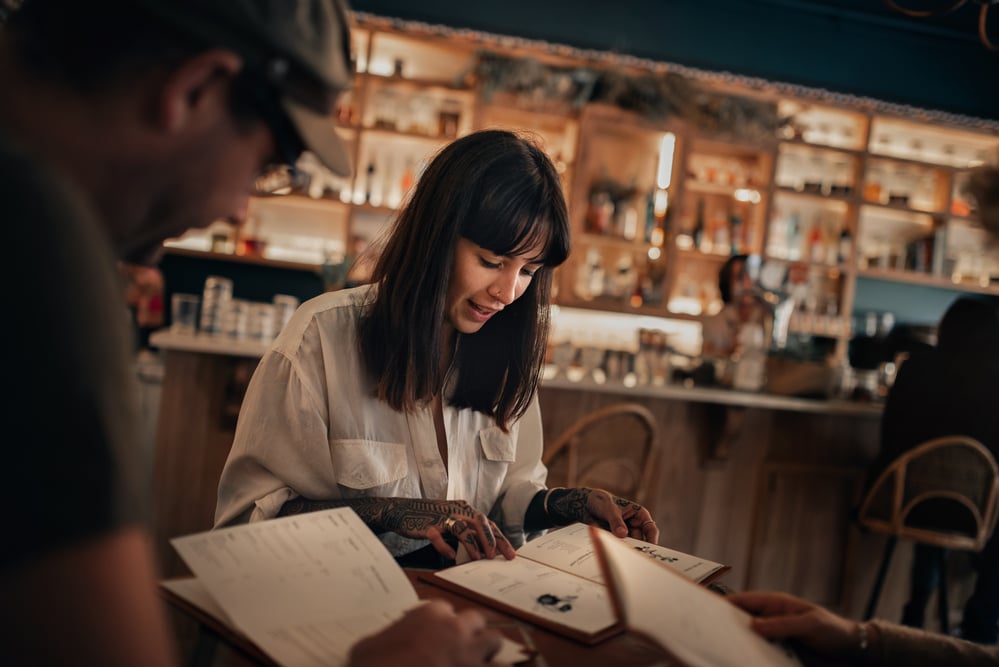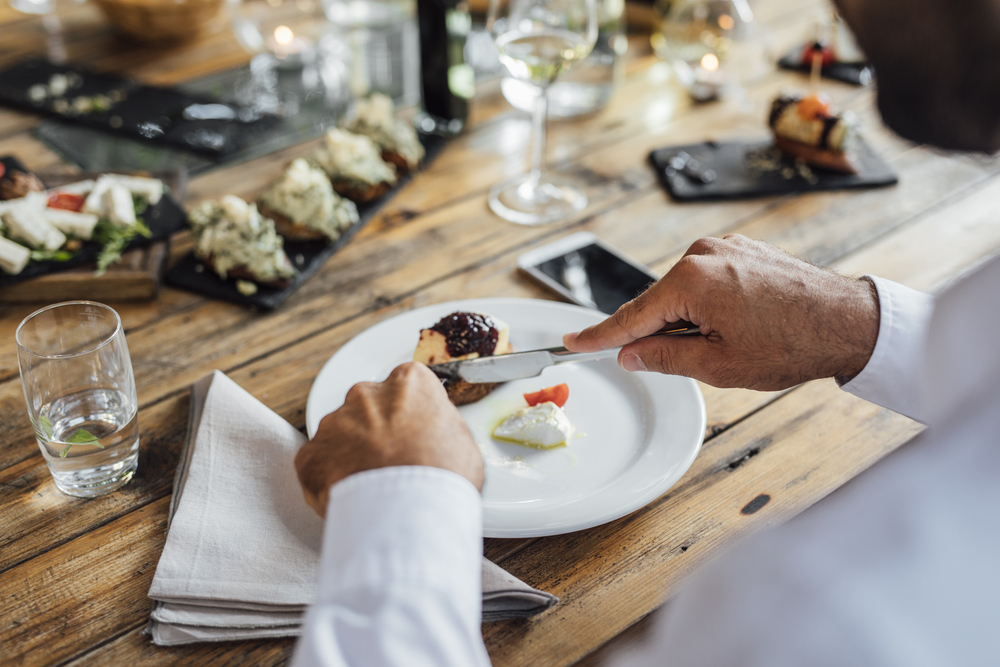Are you finding yourself at a café, restaurant, or bar in the Netherlands and wondering how to order like a true Dutchie?
While it’s usually taken for granted that a Dutch server will understand if you speak English, it never hurts to try your luck at a few Dutch phrases — and who better to practice on than someone who you’ll likely never see again?
Whether you’re a tourist visiting the Netherlands for the first time or an international wanting to flaunt your Dutch outside of the classroom, this article will have you feeling confident by the time you ask for the rekening (bill).
So, wanna have dinner with us? 😉
A table for two, please — and a teacher! Our experience is that the best way to learn Dutch is to follow a language course. That’s why we teamed up with UvA Talen — the independent language centre of the University of Amsterdam. They offer a variety of Dutch courses for internationals at all levels, plus special skill courses such as business or academic writing.
How to get a table at a restaurant in the Netherlands
Once you’ve found an establishment that tickles your fancy, you have a few options. If you’re in the area, you can drop by and reserve a table for later. Otherwise, you can call them up or reserve online.

Making a casual request
It’s not always necessary to reserve a table in the Netherlands. Unless it’s a very popular restaurant or you’re dining out on a holiday (read, Valentine’s Day 😘), showing up should be just fine.
To be on the safe side, you may want to throw in a casual request before claiming a seat:
🇳🇱 “Kunnen we daar gaan zitten?”
🇬🇧 “Can we sit there?”
Likely the server will respond with “Jazeker!” (Sure!) or “Ja, hoor” (Yes, of course).
Alternatively, you may have to wait to be seated, in which case you can ask:
🇳🇱 “Heb je een tafeltje?”
🇬🇧 “Do you have a table?”
Again, the Dutch affirmative will likely be a friendly “Jazeker” or the more inquisitive “Ja hoor! Voor hoeveel personen?” (Yes, of course, for how many people?). That’s when it’s time to flex your Dutch 1-10 skills.
Reserving in advance
Now, there are cases where we recommend not pushing your luck or rocking up to the restaurant entrance when you start getting hangry.
READ MORE | Dutch courses in the daytime, evening, or weekend? UvA Talen offers them all online AND in-class
Dutchies are the champions of time management and are rarely found far away from their agenda. If you’ve got a hot date or an important business lunch, then we recommend adopting the Dutch attitude to appointments — punctual and pre-planned!
Just call the restaurant in advance and say:
🇳🇱 “Hoi! Ik wil graag een tafeltje reserveren voor zes uur vanavond. Kan dat?”
🇬🇧 “Hi! I would like to reserve a table for 6 PM tonight. Is that possible?”
After the restaurant has taken down your name and confirmed your reservation, all that’s left for you is to get ready. 💅
How to order drinks in Dutch
Alright, the first round is on us!
Once you’re comfortably seated at your table, the server will come to pick up your drink order.

“Wat willen jullie drinken?” (“What do you all want to drink?”) and “Kan ik iets voor jullie inschenken?” (literally, “Can I pour you something?”) are the two most common ways for the server to ask for your order.
So, here are some different ways to respond depending on what you’re in the mood for. 🍸
Ordering beer in Dutch
Proost! (Cheers!). Are you seated in a Dutch bar and wondering how to order a beer? Try this on for size:
🇳🇱 “Mag ik een biertje, alsjeblieft?”
🇬🇧 “Can I have a (small) beer, please?”
Fun fact: The Dutch language has a wonderful little construction called the diminutive. Whenever you see a word that ends in -je, it means it’s in the diminutive form and signifies a “little” version of the word. This is the sort of information that you’ll often learn in a Dutch beginner’s language course!
Asking for a “wrong” coffee in the Netherlands — what??
The Netherlands may not be known for its coffee, but the Dutch sure love to drink it. True koffieleuters (coffee lovers)!

Generally, coffees have similar names in various languages — have you ever heard of another name for “cappuccino”? No, right.
Just to keep you on your toes, though, the Dutch have a different word for a latte, which directly translates to a “wrong coffee.”
READ MORE | Dutch at the workplace: your essential phrases for working in the NL
We’ve been told the name came about because lattes weren’t very popular in the Netherlands, and (especially older) Dutchies didn’t think of them as real coffee due to the amount of foamed milk. 🤷♀️
If you’d like to order one, real coffee or not, ask the following:
🇳🇱 “Mag ik een koffie verkeerd, graag?”
🇬🇧 “Can I have a latte, please?”
If koffie verkeerd doesn’t roll off the tongue, then rest assured that you can also just ask for a latte — your barista won’t bat an eye.
Appeltje Eitje! (Easy peasy!)
Requesting the wine card
Craving something a little stronger than coffee? We feel ya! 😅

Sometimes, the wine card isn’t already on the table, but in that case, you can ask:
🇳🇱 “Mag ik de wijnkaart, alstublieft?”
🇬🇧 “Can I have the wine card, please?”
After the server asks if you’re ready to order
So, you’ve sat down, maybe ordered a drink or two, but are still studying the menu when the server approaches your table.
With a smile they ask you:
🇳🇱 “Zijn jullie klaar om te bestellen?”
🇬🇧 “Are you ready to order?”
Or perhaps:
🇳🇱 “Weten jullie al wat jullie willen eten?”
🇬🇧 “Do you already know what you want to eat?”
Panic. You’re not at all ready to order, but a simple “nog niet, wij hebben even een momentje nodig” (“not yet, we just need a moment”) should solve the situation. Seems too long? Just a “nog niet” with a smile will also get the message across.
Once you’re ready to order, you can respond with “Ja, hoor” and start listing your choices. 🍴
How to order food in Dutch
Alright, you’ve decided, and now it’s time to get some food on the table!

When you’re the first to order
If you listen carefully to the tables next to you, you’ll hear different ways to order in Dutch.
So, if you’re the first to order at your table, try saying this:
🇳🇱 “Ik wil graag de…alsjeblieft.”
🇬🇧 “I would like the…please.”
When someone else has already placed their order
Okay, next one up! Another way to order is by saying:
🇳🇱 “Voor mij, de…alsjeblieft.”
🇬🇧 “For me, the…please.”
If you’re ordering the same things as someone else, you can simply tweak the above sentence:
🇳🇱 “Voor mij ook…alsjeblieft.”
🇬🇧 “For me also the…please.”
So far, so good! You’re starting to sound like a true Dutchie! 💪
READ MORE | How to learn Dutch: the ultimate guide (by people who learned!)
How to order dessert in Dutch
With the main course in your tummy, it’s time to satisfy that sweet tooth of yours! Or do it the Italian way, and order some coffee.

Asking for the dessert menu
Likely, the server removed your menus after taking your other orders. So when dessert time rolls around, they’ll either ask you if you want to see the dessert menu, or you can just ask for it yourself.
🇳🇱 “Mogen we de menukaarten terug? Wij zouden even de toetjes willen aankijken.”
🇬🇧 “Can we have menus back? We would like to have a quick look at the desserts.”
Satisfying your sweet tooth
Once you’ve found a to-die-for Dutch dessert, here’s how to order it.
Essentially, you can just couple any of the ways of ordering you’ve learned so far with the dessert that tickles your fancy. So, here are the most common — and more fun — ways of ordering:
- “Ik wil graag de…” (“I would like the…”)
- “Voor mij, de…alstublieft.” (For me, the…please.”)
- “Mag ik de…graag?” (“Can I have the…please?”)
- “De…lijkt me lekker! Ik neem hem.” (The…sounds delicious! I’ll take that.”)
READ MORE | 17 facts about the Dutch language that will make you go ‘echt’?!
How to ask for the bill in Dutch
Once the last plate is polished off and you’ve taken some time to uitbuiken, it’s time to pay. There are a few ways to ask for the bill in Dutch:

🇳🇱 “Kunnen we betalen?”
🇬🇧 “Can we pay?”
Or:
🇳🇱 “Kunnen we afrekenen?”
🇬🇧 “Can we pay?” (Literally, “Can we calculate off?”)
Again, the trusty jazeker is the most common answer for the server to throw your way. This may be followed by “Wilt u pinnen of contant betalen?” (“Do you want to pay with card or cash?”).
Overall, tipping is not compulsory in the Netherlands, but if you feel like you’ve gotten a particularly good service or would like to get rid of some cash, then it’s always appreciated by your server.
READ MORE | Tipping in Amsterdam: all you need to know
Once you’ve paid your bill (and maybe left a tip), take a moment to pat yourself on the back because you just ordered your entire meal in Dutch!
If you stumbled on a few words or sentences along the way, don’t worry. Learning a language takes time, and learning how to tackle specific situations, such as ordering, in Dutch is a great first step.
Want to improve your Dutch even more? Contact UvA Talen to hear more about their many different courses, or take their online test to discover your current level of Dutch.
Go forth and conquer, friends! With these helpful phrases under your belt, you’ve achieved some important first steps to learning Dutch — and we’re proud of you. ❤️
What’s your experience of dining out in the Netherlands? Tell us in the comments below!
Please do not say: “Hoi ik wil graag een tafeltje reserveren”
“Hoi” is not appropriate here. It is only used for close friends, family and young people. In this case you should say “Goedemiddag, kan ik een tafel reserveren voor vanavond alstublieft” Also in all your suggestions it is nicer to replace all the “alsjeblieft” with “alstublieft” wich is the form we use with people that you do not know.
I find Dutch people selling at the food counters really uncomfortable facing foreigners who tries to speak to them in Dutch, say you are with someone who is Dutch and looks like a typical Dutch, then the seller would avoid looking at you or talking to you even if you speak Dutch very well in fact.. maybe they read the anxiety in your eyes if you are not feeling too comfortable in Dutch or if you have little darker skin they just put you in some category and just wont be interested talking with you or looking at you even, it is annoying and funny at the same time.
In Amsterdam at least, a latte is called a latte haha. I’ve never seen it called anything else.